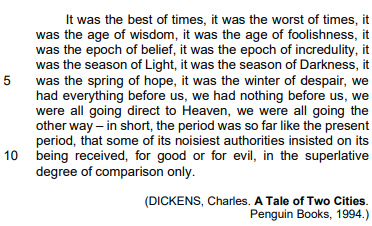Questões Militares de Inglês
Foram encontradas 4.268 questões
Directions: Read Text VI and answer the question accordingly.
TEXT VI

(Extracted from https://www.forbes.com/. Accessed on March
03, 2022.)
Directions: Read Text V and answer the question accordingly.

(SUMMER, Bernard; GILBERT, Gillian; HOOK, Peter; MORRIS,
Stephen. Lyrics to Love Vigilantes, performed by New Order,
Low Life CD, track 1, Universal Music Publishing Group, 1986.
Taken from https://lyricfind.com)
( ) He is driven by a patriotic fervor.
( ) He is fighting because he cares who wins.
( ) He is believed to have been killed in action.
( ) Nothing else in his life seems worth pursuing.
( ) He considers aspects of his past, present and future.
Now, mark the correct option.
Directions: Read Text V and answer the question accordingly.

(SUMMER, Bernard; GILBERT, Gillian; HOOK, Peter; MORRIS,
Stephen. Lyrics to Love Vigilantes, performed by New Order,
Low Life CD, track 1, Universal Music Publishing Group, 1986.
Taken from https://lyricfind.com)
Directions: Read Text V and answer the question accordingly.

(SUMMER, Bernard; GILBERT, Gillian; HOOK, Peter; MORRIS,
Stephen. Lyrics to Love Vigilantes, performed by New Order,
Low Life CD, track 1, Universal Music Publishing Group, 1986.
Taken from https://lyricfind.com)
I. The war referred by the speaker is over.
II. The speaker had been conscripted to engage in combat.
III. Some parts of speech were left out of the phrase in line 4.
IV. The use of the auxiliary verb in line 13 is substandard.
V. The noun in line 17 is a false cognate.
The only correct statements are
Directions: Read Text IV and answer the question accordingly.

Vocabulary:
1. Bid (bade, bidden): to tell somebody to do something.
Directions: Read Text IV and answer the question accordingly.

Vocabulary:
1. Bid (bade, bidden): to tell somebody to do something.
Directions: Read Text IV and answer the question accordingly.

Vocabulary:
1. Bid (bade, bidden): to tell somebody to do something.
Directions: Read Text III and answer the question accordingly.

Directions: Read Text III and answer the question accordingly.

Directions: Read Text II and answer question 03 accordingly.
TEXT II

The extract above
Directions: Look at the chart in Text I. Read the transcript and answer the question.
TEXT I

Transcript:
Q: To what extent, if at all, do you feel that your generation will have had a better or worse life than your parent’s generation, or will it be about the same?
Key: Better
Total
Great Britain

Directions: Look at the chart in Text I. Read the transcript and answer the question.
TEXT I

Transcript:
Q: To what extent, if at all, do you feel that your generation will have had a better or worse life than your parent’s generation, or will it be about the same?
Key: Better
Total
Great Britain

Coal fire crackdown and London mosque stabbing
(Available in: https://www.bbc.com/news/blogs-the-papers-51581385.)
The headline in a British newspaper refers to:
1. It stands for both up-to-date and conventional patterns.
2. People wear it in different ways.
3. Both men and women can wear it.
4. People cannot avoid an arrogant attitude when they put it on.
Mark the affirmative(s) that is/are present in the text.